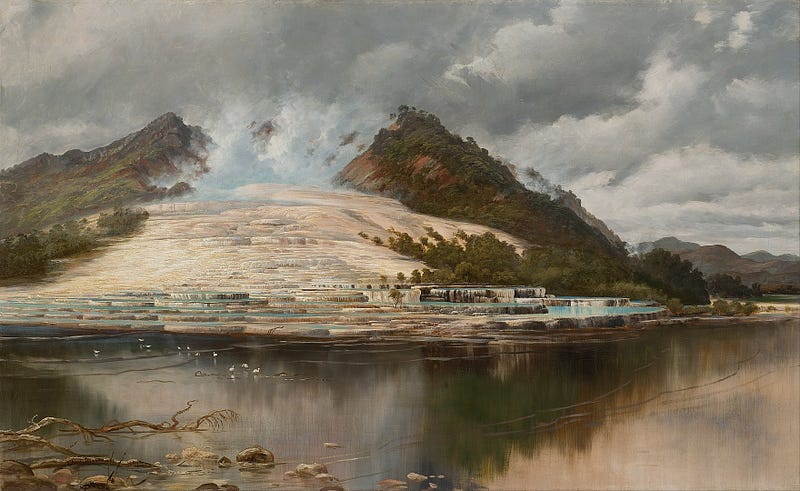Rediscovering the Lost Eighth Wonder of the World
Written on
Chapter 1: The Enigmatic Terraces
The Pink and White Terraces were a breathtaking natural phenomenon that captivated visitors for just a brief period of time before they disappeared from the earth. These striking silica sinter formations contained hot geothermal waters, their stark white surfaces contrasting with the vivid blue steam rising from them. Cascading from the volcanic hills into a nearby lake, the terraces were a regional marvel, enchanting all who encountered them.
The world first learned of these natural wonders in 1841, thanks to a German naturalist who documented his visit in his travel writings. Prior to that, only local officials and indigenous communities were aware of their existence. Tragically, the terraces were known for only a few decades before nature reclaimed its territory.
Section 1.1: Description of the Terraces
The Pink and White Terraces spanned more than 20 acres and featured a dramatic drop of 100 feet. Comprising large circular pools filled with steaming volcanic water, these natural baths provided a perfect escape for visitors. For a fleeting moment, the terraces emerged as New Zealand's most renowned tourist destination.
The Pink Terraces, located higher up, boasted larger and deeper pools with varying temperatures, while the White Terraces below were characterized by whiter silica and cooler waters. The White Terraces descended in fifty layers, dropping approximately 80 feet over a distance of 750 feet before merging with Lake Rotomahana, while the Pink Terraces fell about 70 feet across 300 feet.
For a glimpse of this breathtaking area as it appeared in 1875, one can refer to preserved photographs available online.

Section 1.2: The Catastrophic Eruption
In 1886, the violent eruption of Mount Tarawera changed everything. Hot ash, lava, and volcanic debris surged across the landscape. A massive rift tore through the old Lake Rotomahana, transforming the region overnight. Mud cascaded into valleys, while the intense heat from the eruption caused water to evaporate rapidly.
This catastrophic event marked the most severe volcanic eruption in New Zealand's recorded history, claiming over 100 lives and creating a new rift valley. When the eruption subsided, the Pink and White Terraces had vanished. The landscape was unrecognizable, with smoking craters and altered waterways replacing what was once a serene beauty.
Lake Rotomahana expanded significantly after the eruption, its surface area and depth increasing substantially. It’s widely believed that the remnants of the terraces now lie beneath the tranquil waters of this newly formed lake.
Chapter 2: Nature's Indifference
The eruption serves as a stark reminder of nature’s unpredictable power, highlighting how quickly its beauty can be reclaimed. It’s poignant to consider that the terraces were only truly appreciated by outsiders for a short time before nature reasserted itself.
Had the Pink and White Terraces survived, they likely would have become a commercial hotspot, attracting tourist resorts and global attention. While it's disheartening to think we can't experience this beauty today, nature reclaimed its artistry before human interference could alter it.
The first video titled "8th WONDER Of the World REDISCOVERED in New Zealand!" explores the legacy of the Pink and White Terraces, shedding light on their importance in New Zealand's history.
The second video, "The 8th WONDER OF THE WORLD?" delves deeper into the myths and realities surrounding this natural wonder.
Conclusion: A Reflection on Beauty and History
The Pink and White Terraces were cherished by both locals and visitors, regarded as the largest of their kind globally. Now, they remain a forgotten chapter in history. It’s astonishing that such a unique and mesmerizing wonder could vanish so quickly—formed over eons, yet destroyed in mere hours by nature's fury.
These events teach us that beauty is fragile, history can easily fade, and nature's might is unparalleled. Thankfully, courageous artists of the Victorian era captured the scene through their paintings before it was lost forever.

